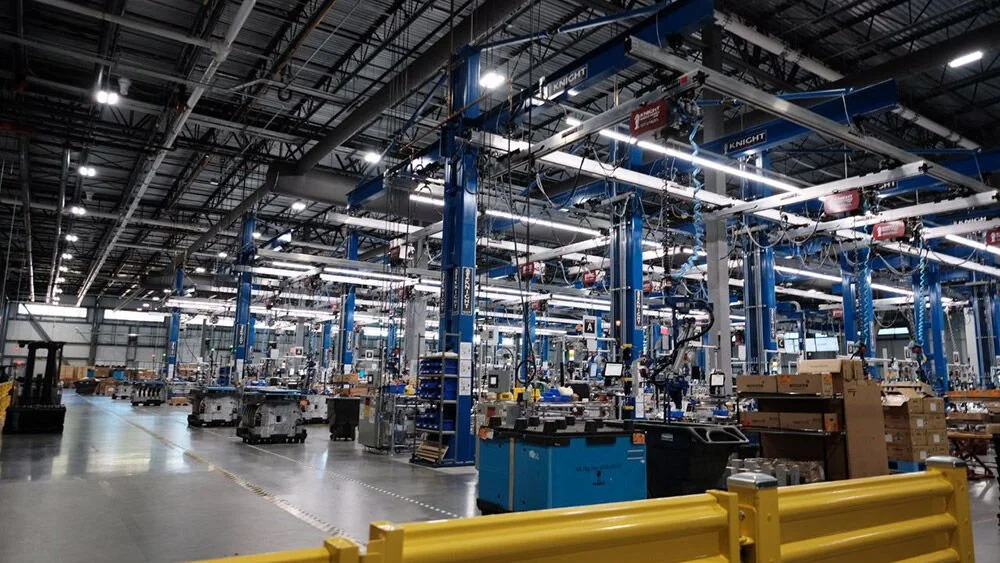Amazon unveils state-of-the-art warehouse picking robot
Sparrow is Amazon’s new intelligent robotic system that streamlines the fulfillment process by moving individual products before they get packaged—a major technological advancement to support our employees.
With Sparrow, Amazon’s latest robotic arm, repetitive product picking tasks currently performed by workers can now be alleviated, as Sparrow is able to identify and sort over a million different individual items. This is an element which still requires human intervention before an order is boxed up and sent out the door, but the aim for Sparrow is to tap onto computer vision and AI, to help employees cut down repetitive motion when picking packages.
Sparrow joins previously announced Robin and Cardinal robot arms which were better equipped to handle products after they have been packaged into predetermined packaging and boxes.
At the recent Delivering the Future event, held at Amazon’s innovation labs and robotics manufacturing facility outside Boston, Massachusetts, the company showed new robotic enhancements that will improve the experiences of the warehouse staff and better serving the customer when these are eventually rolled out across its facilities.
The company unveiled “Sparrow,” a robotic arm that can pluck millions of items of varying shapes and sizes, on stage at the Delivering the Future conference near Boston, where it showcased new robotics, transportation and last-mile delivery technologies.
Amazon says Sparrow uses computer vision and artificial intelligence to move products before they’re packaged. A video of Sparrow shows the robotic arm picking up a board game, a bottle of vitamins and a set of sheets — all the kinds of items that might flow through one of the company’s warehouses — and deftly placing them in crates.
Suction cups attached to the surface of the robot allow it to firmly grasp items. Previous iterations of robotic arms have been able to pick up boxes, which are generally uniform in their shape but might vary in size. But Sparrow is capable of handling items with varying curvature and size, said Jason Messinger, principal technical product manager of robotic manipulation at Amazon Robotics, in a demonstration.
“This is not just picking the same things up and moving it with high precision, which we’ve seen in previous robots,” Messinger said.
The robotic arm can identify around 65% of Amazon’s product inventory, the company said.
While the introduction of robots to the warehouse often raises questions about whether human jobs will be replaced, Amazon says Sparrow will “take on repetitive tasks,” freeing employees up to focus on other things.
The company also said the technology can improve safety in the workplace, although that prospect has been debated. An investigation by Reveal from the Center for Investigative Reporting found the company’s warehouses with robots have higher injury rates than facilities without automation.
Amazon has steadily added to its fleet of warehouse robots since it acquired Kiva Systems for $775 million a decade ago. Kiva evolved into Amazon Robotics, the company’s in-house incubator of robotic fulfillment systems.
By adding more automation to its fulfillment centers, Amazon could reduce its dependence on front-line workers to handle the picking, packing and shipping of items in its warehouses. That vision is more relevant than ever as the company, which is the second-largest employer in the U.S. behind Walmart, could run out of workers to hire in the country by 2024, Recode reported.
About 75% of the 5 billion packages processed by Amazon annually are handled by robots in at least one part of the delivery process, the company said Thursday.
Amazon in June unveiled its first fully autonomous robot that can operate alongside warehouse workers, in addition to other systems that can sort and move packages. It also acquired Cloostermans, which develops warehouse machinery and robotics.
The use of robotics does not end once the parcel leaves the warehouse, as Amazon is further exploring the use of drones to fulfill last mile delivery. Having announced a flying drone in the form of the MK27-2 drone earlier in 2022, it’s now testing a new MK30 drone that is smaller and lighter than its predecessor.
Other improvements to the drone include an increased flight range, ability to fly in light rain, and being capable to land in backyards. From the information revealed at the event, the drone ferries a maximum package load of up to 2.2kg.
The real challenge for the drones to see widespread adoption boils down to how regulators view the delivery devices, as a fleet of drones filling the skies over a city with parcels to deliver might not be the most noise-free activity, which is why Amazon is endeavouring to reducing the MK30 drone’s noise generated by 25%, through the implementation of custom designed propellors.
With Amazon’s drone delivery, known as Prime Air, slated to go live later in the year in two cities – Lockeford, California and College Station, Texas, there are still things to be done before they become a norm, but if it becomes a reality, instead of Santa dropping down from the chimney, it might be a flying drone with presents.






